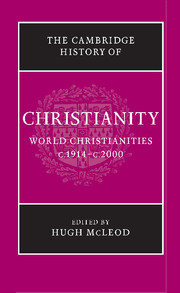Book contents
- Frontmatter
- 1 Introduction
- 2 Being a Christian in the early twentieth century
- PART I INSTITUTIONS AND MOVEMENTS
- PART II NARRATIVES OF CHANGE
- 8 The Great War
- 9 The Christian churches and politics in Europe, 1914–1939
- 10 Latin America, c.1914–c.1950
- 11 African Christianity: from the world wars to decolonisation
- 12 The African diaspora in the Caribbean and Europe from pre-emancipation to the present day
- 13 Christianity in the United States during the inter-war years
- 14 Christian churches in Australia, New Zealand and the Pacific, 1914–1970
- 15 Catholicism and Protestantism in the Second World War in Europe
- 16 The Cold War, the hegemony of the United States and the golden age of Christian democracy
- 17 The religious ferment of the sixties
- 18 The crisis of Christianity in the West: etering a post-Christian era?
- 19 The revolutions in eastern Europe and the beginnings of the post-communist era
- 20 The transformation of Latin American Christianity, c.1950–2000
- 21 Religion and racism: struggles around segregation, ‘Jim Crow’ and apartheid
- 22 Post-colonial Christianity in Africa
- 23 South Asia, 1911–2003
- 24 Christianity in South-East Asia, 1914–2000
- 25 East Asia
- PART III SOCIAL AND CULTURAL IMPACT
- Bibliography
- Index
- References
23 - South Asia, 1911–2003
from PART II - NARRATIVES OF CHANGE
Published online by Cambridge University Press: 28 March 2008
- Frontmatter
- 1 Introduction
- 2 Being a Christian in the early twentieth century
- PART I INSTITUTIONS AND MOVEMENTS
- PART II NARRATIVES OF CHANGE
- 8 The Great War
- 9 The Christian churches and politics in Europe, 1914–1939
- 10 Latin America, c.1914–c.1950
- 11 African Christianity: from the world wars to decolonisation
- 12 The African diaspora in the Caribbean and Europe from pre-emancipation to the present day
- 13 Christianity in the United States during the inter-war years
- 14 Christian churches in Australia, New Zealand and the Pacific, 1914–1970
- 15 Catholicism and Protestantism in the Second World War in Europe
- 16 The Cold War, the hegemony of the United States and the golden age of Christian democracy
- 17 The religious ferment of the sixties
- 18 The crisis of Christianity in the West: etering a post-Christian era?
- 19 The revolutions in eastern Europe and the beginnings of the post-communist era
- 20 The transformation of Latin American Christianity, c.1950–2000
- 21 Religion and racism: struggles around segregation, ‘Jim Crow’ and apartheid
- 22 Post-colonial Christianity in Africa
- 23 South Asia, 1911–2003
- 24 Christianity in South-East Asia, 1914–2000
- 25 East Asia
- PART III SOCIAL AND CULTURAL IMPACT
- Bibliography
- Index
- References
Summary
Christians of south Asia have always consisted of many ‘communities’, distinguished according to region, language, caste and church tradition. Some are products of relatively recent conversions, while others belong to older, more established, traditions. During the twentieth century, socio-political changes related to Indian nationalism, constitutional reforms and caste politics prompted new forms of theological reflection and new avenues for public engagement. Rather than remaining within their niches, different classes of Christians considered how best to stake their claims within an evolving public domain and inscribe a more collective Christian identity upon the canvass of nationhood. Could an ‘Indian Christian community’ be attuned to local, nationalistic and international developments at the same time, or would these different sites of engagement remain in constant tension with each other? Challenges concerning the status of Christians within the Indian nation presented themselves poignantly during the decades preceding independence (1947) and continue to this day.
The Indian church
Indian Christianity consists of three principal branches: Syrian (or Thomas) Christian, Roman Catholic and Protestant. During the colonial period, Christians belonging to the oldest church of India, the Thomas Christians, were mostly concentrated within the princely state of Travancore, or what is now Kerala. Significant numbers of Thomas Christians also resided within the Malabar district of British south India. They traced their origins to the apostle Thomas, who allegedly came to India and converted a number of Brahmins along the Coromandel coast near Mylapore.
- Type
- Chapter
- Information
- The Cambridge History of Christianity , pp. 422 - 435Publisher: Cambridge University PressPrint publication year: 2006



